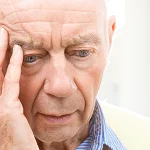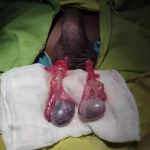Some hormone therapies for prostate cancer can cause swelling and tenderness in the breasts. This is gynaecomastia (pronounced guy-nee-co-mass-tee-ah).
What is gynaecomastia?
Gynaecomastia is swelling or enlargement of the breast in men.
What causes breast swelling in men with prostate cancer?
Hormone therapy is a common treatment for prostate cancer. This can change the balance of hormones in your body and cause breast tissue to grow.
What is the treatment for gynaecomastia?
You might have radiotherapy, a drug called tamoxifen or surgery to remove the breast tissue. Talk to your doctor about what is best for you.
Why does hormone therapy cause breast swelling?
Hormones occur naturally in your body. They control the growth and activity of normal cells. Testosterone is a male sex hormone mainly made by the testicles.
Men also have a small amount of oestrogen circulating around their bodies.
Prostate cancer usually depends on testosterone to grow. Hormone therapy blocks or lowers the amount of testosterone in the body.
When hormone therapy lowers your testosterone, this changes the balance of hormones in your body. And you have more oestrogen compared to the level of testosterone. Oestrogen stimulates the growth of breast tissue.
Swelling can happen in either one or both breasts. It may be painful. It starts as fatty tissue. But it can develop into thicker (dense) tissue. This is glandular tissue.
Ask your doctor how likely it is that your breast tissue will get swollen before starting hormone therapy. Breast swelling is more common with some types of hormone therapy. This includes bicalutamide when you take it for longer than 6 months.
Treatment for breast swelling
Hormone therapy, such as bicalutamide, may last for several years. Your doctor may suggest treatment to reduce the risk of breast swelling if your treatment is likely to be longer than 6 months.
Treatment might include:
- radiotherapy
- tablets such as tamoxifen
- surgery
Radiotherapy
Radiotherapy uses high energy x-rays to reduce the swelling. It’s the main treatment for preventing and treating breast swelling. It is called breast-bud radiotherapy. You have one or two sessions of radiotherapy and it’s a very small dose.
The skin around your nipple may be red and sore for a few weeks after the treatment. There is a small risk of cancer developing in the radiation area many years after treatment. Your doctor will talk to you about this.
Tamoxifen
Tamoxifen works by blocking oestrogen. This slows down breast tissue swelling. Research suggests that in men taking bicalutamide it can:
- prevent breast swelling
- reduce swelling and pain
Tamoxifen can cause side effects such as hot flushes.
It’s unclear how tamoxifen might affect how well hormone treatments work for prostate cancer. We need more research to find out. Your doctor might suggest tamoxifen if radiotherapy does not help your breast swelling.
Surgery to remove breast tissue
You can have any excess breast tissue removed. The surgeon makes a cut (incision) around the nipple to leave it in place and minimise any scarring.
After surgery you might have:
- bleeding
- flattening around the nipple
- an inverted nipple
- loss of feeling in the breast
Another way of removing breast tissue is to suck out the excess fatty tissue with liposuction. Liposuction works better if the swelling is made up of fatty tissue. Men having hormone treatment for prostate cancer tend to have glandular tissue, which is thicker. Glandular tissue is more difficult to suck out than fatty tissue.
There is some research that suggests combining surgery with sucking out the fat may work better.
Feelings about breast swelling
Breast swelling and breast pain can be very distressing and difficult to cope with. Many men feel embarrassed and less confident about themselves when they have it.
Tell your doctor or nurse as soon as possible if you have breast swelling and haven’t had advice or treatment. They can work out the best treatment for you and offer support.



